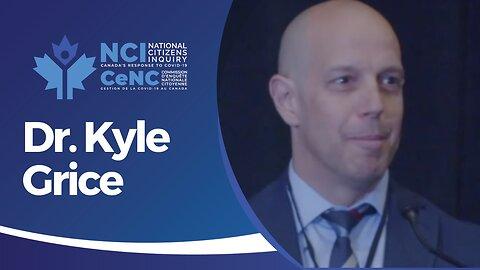Dr. Kyle Grice became more involved with his community during the pandemic and is spreading the concept of regenerative agriculture. He said, “we’ve created a network to come together to create these solutions. There’s so much that’s gone on and it is so hopeful for what we’ve seen in the communities, of what’s transpired, what’s motivated. We’re connecting to people who’ve been working on things for decades, people who’ve been working on removing hunger and removing poverty and increasing well-being and health for people.”
* The above video is being streamed via Rumble. Check back often as we continue to update the complete list of links to all witness testimonies in both video and audio/podcast formats.
[00:00:00]
Kassy Baker
First things first. Mr. Grice, can I please have you state and spell your name for the record?
Dr. Kyle Grice
It’s Kyle Grice, K-Y-L-E G-R-I-C-E.
Kassy Baker
Now do you promise that you will tell the truth, the whole truth, and nothing but the truth during your testimony here with us this afternoon?
Dr. Kyle Grice
I do.
Kassy Baker
Very good. Now I understand that you are here to speak to us about community response. It’s a bit of a, hopefully, more optimistic look towards the future than we have sometimes been hearing about during the Inquiry.
Can you begin by just telling us a little bit about yourself? Where are you from? Are you married?
Dr. Kyle Grice
Yes. I’m from Milton, Ontario. And my family is there; two teenage boys and my wife live there. I’m a chiropractor in Toronto. I have a family practice there with my sister.
Kassy Baker
And that’s you. So just to clarify: you are a chiropractor, but you are actually not here speaking as a chiropractor or on behalf of the chiropractic community, is that correct?
Dr. Kyle Grice
That’s correct, yes. This is more about my community engagement and some of the endeavors that have happened from that community engagement.
Kassy Baker
Very good. With that introduction, if you would like to start your slide presentation, I believe that we’re ready.
Dr. Kyle Grice
I’m not going to start it yet because I was asked to actually tell the story of how I got to being involved in the community.
And what inspired me was actually the harms that I was seeing.
I was seeing harms in my family. My father had an injury in 2016 and became a quadriplegic. From that time, he worked like an Olympian to regain his mobility. And he had limited mobility, but he was able to walk. And he had a safe place to walk and that was in his community centre. It was a flat, open track, and he would call me up and say, “Hey, son, I did two laps today without having to sit.” In 2020, he was continuing to improve his mobility and his function. And with lockdowns, they closed that community centre.
With closing that— it was the only safe place for him with his walker to walk. And there was a significant, rapid decline, as an 84-year-old man, in his capacity to walk. To this day now he has such trouble, he can barely transition from his chair to his chair. He’s not able to regain the function that he lost because of that.
My wife’s mother developed breast cancer in the spring of 2021. She had successful surgery to remove the cancer and was instructed to have radiation therapy. Because of COVID measures, there was improper follow-up to her radiation. And what ensued was the burning of her left lung and her left heart from the radiation. This caused her to have to be hospitalized for this. And the nine days that she was alone in hospital, with difficulty breathing and hearing impaired, it was hell for her. She would call my wife every night crying, not knowing what was going on with her, not understanding what was happening, and just wondering when she could come to the hospital. When my wife did finally get to see her— the decline in her health was significant when she did eventually get to see her. She did succumb eventually to those injuries from the radiation.
There were also dozens and dozens of stories that we were getting in our practice from patients, just revealing what they were experiencing and the stresses they were going through because of the COVID response. We were helping them through that as best we can.
One such gentleman I remember, a married father of two, lost his job because of his choice. And he said, “I’m okay about that.” But I realized he wasn’t. He was recognizing the greater picture of what was going on
[00:05:00]
and he was significantly stressed. This man—from the beginning when I met him: healthy, strong, he was a wrestler—declined significantly in that year. He lost body weight, lost lean body mass; he developed a bowel disorder, it seemed like it was an inflammatory bowel disorder from the stress. That has yet to be diagnosed, but there was a significant decline in his health.
We all heard stories like this; we just got repeated stories. My life’s work has been about helping people. I’ve dedicated my life to helping people. And when I was seeing this go on, it compelled me to get more involved. That’s when I started to get involved in the community. I was hearing of these meetings that were going on all over Ontario. And I started attending these meetings.
And if I could start the slide show now [no exhibit number available].
It was quite amazing, actually. People were coming together because of COVID response. These were people who lost relationships: they lost relationships with their family; they lost relationships with their friends; they lost their ability to socialize in the establishments that they could once go to. They lost their ability to go to their churches. They were, in essence, excluded from society.
When they were coming together and I was meeting with them, the fear that I had with these people, that I felt from these people and heard: they were talking about what was in the news—with perhaps the loss of healthcare that they might have, that was put through the news. These people got afraid of that. They thought, they’ve been shut out of all these other establishments, what if they shut us out of the grocery store? This is what these community people were feeling.
And what they started to do was they started to come together. They found a place to socialize. Because society excluded them, they came together through this network of support. They started to develop solutions of, “Where will we get our healthcare if they take that away? Where will we get our food if they take that away?” They started making connections to local farmers and getting these food hubs organized. And it was amazing because, in essence, they were building community.
In one of these meetings, I met Dr. Jeff Wilson. He will be testifying after me. And I met several other scientists and professors during these meetings as well. In one of them, we ran a designed thinking process through the guidance of Dr. Jeff Wilson, where we did a National Consensus Conference on COVID Response.
This was using the process that I’ll talk about later. It’s called community network integration. I learned this from Dr. Jeff Wilson. What it does is solicit insights from the experts, stakeholders, and the public. It’s bringing people together to come up with the solutions we need to do in order to overcome what is happening. We created a report based on the summary of this designed thinking process. The results of this are being written up in a summary that we are submitting as a joint submission to the Canadian Journal of Veterinary Medicine and the Canadian Journal of Public Health. That’s ongoing right now.
What’s interesting: when the COVID measures began to wane, these communities that were coming together, they stayed together. And they started to look at what happened; what was going on; who’s responsible—how do we not let this happen to us again? They stayed meeting. And still to this day, all over Canada, there are people in communities that are coming together—and I’ll talk about that in a little bit, what’s formed.
They recognized some of the same players that brought us COVID response are now also involved in these international institutions like the WHO and the UN. They are ushering in community solutions. They see this transition, and it is called Agenda 2030, the Sustainable Development Goals. Interestingly enough— I didn’t put it in my presentation; I didn’t have time to change it, but I just spoke with one of the principal investigators yesterday. Because he wrote a Substack this week that piqued my interest and I had to speak with him about it before today. Because what’s happening is that the UN, the Government of Canada, and the Canadian Health Research Institutes are also funding and giving research money to look at COVID recovery.
[00:10:00]
This particular investigator, this researcher, has now been given a nice lump sum of money to look at COVID response. And the first place they’re starting is by looking back at the last three years, doing an evidence-based approach to investigating what happened, what went right, what went wrong. They actually, in this grant, have been asked to submit this to the United Nations as one of the grant’s requirements.
It’s interesting, I’ve been looking at— the UN Research Roadmap [for the COVID-19 Recovery] is what they have because there is this interest in investigating what’s happened and what we need to do about it. And they are putting a lot of emphasis on Agenda 2030 and the Sustainable Development Goals as part of COVID recovery. And we’re doing our best—and I’ll talk about this, how we are going to bring everybody together. That’s our motion, is bringing those in the UN, those in the public, the researchers, the stakeholders together. Our process that we’re doing—and I’m working with Jeff Wilson and many others across the country—is to bring people together so that we can design these solutions together.
One of the concerns—I’m sure this has been talked about in other testimony—of those in the community that I’ve been meeting with on a regular basis is the WHO pandemic treaty. Canada has signed on to this treaty and the people in the communities are fearful and distrustful that they may not handle a pandemic properly. There’s evidence through— They feel the COVID response has been mishandled. They’re leery of giving up sovereignty of a pandemic response to the WHO. And Dr. Jeff Wilson, who’s speaking after me, is going to be talking about outbreak response. And that Canada has the expertise; we have the knowledge; we have the manpower to make our own pandemic response that’s Canadian- made and will suit what we need to do for Canadians.
This is just more about— the UN and the World Economic Forum did make a strategic partnership in 2019. And this was about putting forward Agenda 2030, the Sustainable Development Goals. When we look at those goals, they are noble goals to have. And people in communities, though, are concerned: What are we going to be doing and how are we going to be achieving these goals? That’s vitally important. What measures and what initiatives will we be putting forward for us to achieve these goals?
This is a big concern. People do not want to be dictated to. They don’t want a top-down centralized control mechanism telling them how to run their communities. They’d like to be part of it. This, I feel, is the epitome of public interest, is involving the public in this process.
This just shows that partnership— the 17 Sustainable Development Goals, which is being rolled into COVID recovery as far as the UN and Canada is concerned— this is one of the ways in which they’re bringing about these Sustainable Development Goals, this ICLEI, it’s I-C-L-E-I. If you look up their website, it’s an international organization of local governments for sustainability. Canada has its own chapter of this institution, and there are different regions, cities, and communities that have signed on as members of ICLEI Canada. And this is where the people in the communities are working to collaborate with these organizations to be part of what the solutions are, rather than being dictated to. This is how the UN and the World Economic Forum are getting into our local communities.
[Witness moves forward to slide entitled Canada Smart City Challenge]: Canada is participating in this. I’m just going to show a couple of examples of this. This just reminds me too— sorry, I didn’t mention this earlier, but I completed my master’s in Integrative Population Health through doing that pandemic response paper. I looked into things like this as well: the Canadian Smart City Challenge. Different municipalities participated across Canada, looking at how to build infrastructure to meet the Sustainable Development Goals.
Most of it was geared around technology. And here’s a list of the technology of putting this in place in the cities. You may have seen different things happen in your city: the new lights, there’s all the different LED lights that are connected to the network. Just little simple things like that, augmented reality, Internet of Things, the list is there. This is what initiatives are happening as infrastructure to Canada.
[00:15:00]
I like this quote from Albert Einstein, “We can’t solve problems using the same kind of thinking we used that created them.”
There is a transformation that’s happening; it is written all over the United Nations Roadmap to Research. They’re talking about transformation. They’re talking about, “Are [we] going to go back to 2019 as the status quo?” And this isn’t me talking, this is quoted from them: “Are we going back to the status quo of 2019 or are we going to do things differently?” There is a social reorganization that’s happening. And Canadians in the communities that I’m connected to are concerned: How we are going to do that?
And we feel we’ve brought forth some solutions.
This is happening already, there’s a national collaborative network. Those communities that were coming together across Canada, that built their community and they’re staying together: there’s a national collaborative network of them across this country. It’s actually across the world, but we’re connected mostly to your local regions and further. We’re using the process called Community Network Integration [CNI]. Dr. Jeff Wilson will talk a little bit more about that in his testimony as well.
You can see it’s a leaderless network of communities and people that are coming together to solve these big problems that we’re having in our society.
Another such example of this Community Network Integration is the National Poultry Network. I happen to be in that network. I do not know much about the poultry industry, but for whatever I do know, I can provide some support to this network.
This CNI approach is bringing together all the stakeholders: the business owners and the government is coming on board. We’ve got— The Canadian Food Inspection Agency is on this network. PHAC, the Public Health Agency of Canada people are there to help with their input, right down to chicken farmers and all the stakeholders in between. Because there’s a problem with avian influenza potentially. Dr. Jeff Wilson will talk more about this, but there’s the development underway of outbreak response for avian influenza, respecting the pillars of outbreak [response]. Also what’s going on in here is looking at regenerative agriculture practices that we can implement in the poultry industry.
In this format, if we do a collaborative process like this, this industry can solve any problems that they’re faced with, in our opinion.
This one is my favourite. Food security has been talked about. This is part of the Sustainable Development Goals. And that word “sustainability” has been thrown around a lot; it’s been used a lot, “sustainable.” And it is noble. It is— in essence, its definition is to do less harm now so that we have resources for the future. It’s a noble cause. But what I’ve found— my family has purchased a farm and what we’ve done is we have implemented a regenerative farming practice into that. We have connected with people in regenerative agriculture. And what I’ve found through doing this is that there is a network of people across the country involved in regenerative agriculture. And it’s different than sustainability.
Kassy Baker
Just, sorry, if I can interrupt you for one second. Can you just explain what you mean by regenerative agriculture?
Dr. Kyle Grice
The principles of regenerative agriculture are looking at restoring and rejuvenating the natural world and respecting the laws that God put in place for how nature has created life on earth and has the abundancy that it has. There’s certain laws and rules that apply that nature provides us. And it’s respecting those rules in how we grow our food.
Kassy Baker
Can you give us an example of one of those rules?
Dr. Kyle Grice
I’m just learning this process myself because we’ve just done that, but it’s about how—and I took ecology in university. And it’s just the circular nature of all aspects and the interrelationship of living organisms. For instance, we breathe out carbon dioxide and trees breathe in carbon dioxide. We all know this, we all learned this in Grade 6—that there’s this cyclical nature to how it works. And it’s respecting those laws in how we grow our food.
Our industrialization of food production has been fantastic for providing food for us,
[00:20:00]
although the UN is also talking about this. We have to change the way we’re doing things. And they’re going to use COVID recovery to do this. We’ve brought together a national regenerative agriculture network bringing people together to see, how we can scale up regenerative agriculture to meet the food needs of our nation?
One of the other principles of regenerative agriculture is to increase productivity out of a square footage or square acreage or hectares. So there’s less that goes into regenerative agriculture because it’s based on principles of recycling and reusing. And then it intensifies the food production per square acreage of an area. So as a business model, this is a fantastic business model. Less in, more out, right?
It also makes sense as far as wanting us to meet our goals of— whatever sustainable goals that we have put before us, whatever that might be, regenerative agriculture is one of the answers to this.
And we’ve created a network to come together to create these solutions. There’s so much that’s gone on and it is so hopeful for what we’ve seen in the communities, of what’s transpired, what’s motivated. We’re connecting to people who’ve been working on things for decades, people who’ve been working on removing hunger and removing poverty and increasing well-being and health for people.
We’re connecting all these people and we hope— we know. Actually, we know. We’re going to bring trust, cohesion, and collaboration back together with the public, the stakeholders, the government, the agencies. We have to do it if we’re going to solve these problems. And what’s amazing is it’s already happening. So I’m incredibly hopeful.
I’ve heard some of the testimony of the harms that people have experienced, and I can only imagine that there are several feelings that people might have. I know that there’s anger. There’s a lot of anger in the community. There’s also a lot of despair. People feel helpless and hopeless against these big things and those are the people we don’t see. But I hope we can reach out to them to say, “You know what? There’s things happening. And there’s a way for you to get involved. And don’t let what’s happened to you go to waste. Let’s do something about it. Get out there and help.”
That can probably help some of the despair that they’re feeling. It can help to create some energy and channel that anger into some fruitful endeavours. We feel that’s happening. It’s naturally happening, we want more people to get involved.
Kassy Baker
And if people do want to get involved, what steps specifically can they take to work towards this model?
Dr. Kyle Grice
Across Canada. And no matter what community you’re in, there will be people that are coming together. You have to just start talking to people. Just start talking to people. And that’s all I did. To get connected to the community, I just started asking. I just started asking around and people just started connecting— that’s how the network works, they just start connecting to people. And it won’t be hard, it won’t be too far away.
And if you don’t find it, create one yourself, right?
Kassy Baker
Very good. Is there anything else that you would like to add at this time?
Dr. Kyle Grice
No, I think that’s it.
Kassy Baker
Very good. Are there any questions from the commissioners?
Kassy Baker
Okay, I think that’s everything.
We thank you very much for your testimony, Mr. Grice. And on behalf of the National Citizens Inquiry, we’d like to thank you.
[00:24:04]
Final Review and Approval: Jodi Bruhn, September 6, 2023.
The evidence offered in this transcript is a true and faithful record of witness testimony given during the National Citizens Inquiry (NCI) hearings. The transcript was prepared by members of a team of volunteers using an “intelligent verbatim” transcription method.
For further information on the transcription process, method, and team, see the NCI website:
About these Transcripts
Credentials
- Chiropractor
Summary
Dr Kyle Grice presented on the topic of community engagement. He described how the COVID measures created personal and community stresses that caused people to form community groups to work on solutions. There is now a national collaborative network of community groups continuing to work together, under an umbrella called Community Network Integration.
Dr Grice began his presentation by describing how his own family members were impacted by the COVID restrictions. His 84-year-old father who uses a walker for regular exercise declined quickly because the places that were safe for his walker were off-limits due to lockdowns. His wife’s mother was unable to access proper medical follow-up for her cancer surgery and ended up isolated in hospital as family was not allowed to visit.
Dr. Grice described being amazed that the social stresses of the COVID crisis prompted gatherings of the excluded. These community groups worked on such issues as finding supportive healthcare, accessing quality food and organizing community food hubs. After the COVID emergency measures waned the groups continued to meet to discuss emerging issues such as Agenda 2030, the revisions to the WHO Pandemic Treaty, food security and regenerative agriculture, Smart Cities and the challenges of new technology. The Community Network Integration has as its goal returning trust, cohesion and collaboration to Canadian society.






















